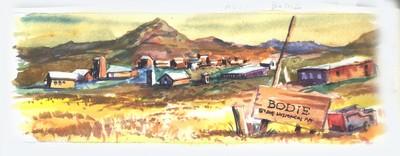Ghost town frozen in time
Visitors to Bodie ghost town, a California state historical park, take a fascinating excursion into yesteryear when they explore the remnants of the 1880s boomtown. Preserved in a state of "arrested decay," old Bodie appears much like it did when the last residents departed more than 50 years ago. Leaving personal belongings, home furnishings and merchandise in stores, the final population also left a kind of time capsule for future visitors to interpret.
Bodie lies 13 miles east of U.S. 395 from a turnoff seven miles south of Bridgeport in the shadow of the Sierra Nevada peaks. Although the first 10 miles of the Bodie Road are paved, the last three miles are gravel, curvy and rough. Signs warn against towing trailers over this route. The road ends in a parking lot overlooking the old town.
Although the park remains open all year, winter visitors take their chances. Bodie's 8,400-foot elevation makes snow a certainty most winters. Since even four-wheel drive vehicles risk getting stuck, officials recommend winter visitors use over-snow vehicles like snowmobiles. The few months between snowmelt and the first storms in October remain Bodie's best season.
The park stays open from 8 a.m. to 7 p.m. through Labor Day. The rest of the year visitors find the park gate open at 8 a.m. and closed at 4 p.m. Expect to pay a $3 entrance fee for adults and $1 for children younger than 16 years.
Bodie received designation as a state historical park as well as listing on the National Register of Historical Sites in 1962. In 1994 the state bought up surrounding mining claims whose proposed development threatened the old town's existence. To preserve Bodie's authentic character, park officials deliberately keep the buildings standing with minimal maintenance, little restoration and few developed facilities.
Park facilities include a free museum and visitor center open from 9 a.m. to 6 p.m. from mid-May to mid-October. Visitors picnic at an area within the park. Restrooms with flush toilets are located at the parking lot and near the picnic area. The park remains a day-use area only. Campers find public campgrounds in nearby Inyo National Forest or private campgrounds or RV parks in nearby towns.
At the museum pick up information for the absorbing self-guided tour of the remaining streets and buildings of Bodie. As visitors explore, they peer into the past through dusty windows of houses still furnished and stores with shelves still stocked. Fortunately for the experience, the prohibitive cost of shipping from Bodie forced most of the last residents to pack lightly when they left. Some areas of the town deemed dangerous will be off-limits to exploration.
Bodie took the name of the man who first discovered traces of gold in the area north of Mono Lake, although he spelled it differently. A little camp grew up that became a full-fledged boomtown in 1877, when a major strike signaled a gold rush to the remote region. By 1879, the new town contained 2,000 buildings. It soon ranked as California's third largest city with a population of 10,000. It might have ranked first in lawlessness brought by criminals elements lured by the promise of quick riches. Bodie's buildings housed at least 60 saloons, bawdy houses and an overcrowded Chinatown complete with opium dens. Bandits plagued the roads to Bodie and its mines and mills.
The buildings still standing represent a 10th of Bodie at that time. Fire constantly menaced the town as it was far cheaper to build of wood available locally than it was to import fire-safe brick and metal. In the days before electricity, residents burned candles or kerosene lamps for light and kept the brutal winters at bay with wood fires. After some businesses and homes burned in a conflagration in 1892, residents rebuilt with wood. A major fire in 1932 swept the old town, leaving just 10 percent Bodie standing when the smoke cleared.
By that time Bodie had far fewer people left to rebuild. Its decline began in the 1880s.
By 1886, just 1,500 people called Bodie home. Decades later, better methods of extracting gold from ore only briefly improved its fortunes. Bodie epitomizes the boom and bust cycle of mining towns throughout the Old West.
Margo Bartlett Pesek's column appears on Sundays.
MARGO BARTLETT PESEKMORE COLUMNS






















